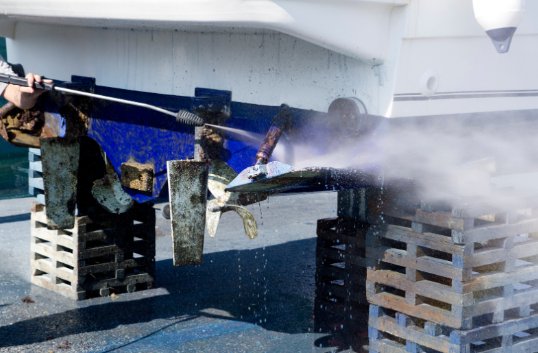Before you set sail on your boat for the upcoming boating season, it’s essential to ensure that your vessel is in prime condition. Proper boat preparation not only guarantees a smooth and enjoyable experience but also enhances safety on the water. In this comprehensive guide, we’ll walk you through the steps to get your boat ready for the water, from hull inspections to safety precautions.
Hull and Propeller Inspection
The first step in preparing your boat for the water is a thorough inspection of the hull and propeller. The hull is your boat’s foundation, and any issues here can lead to leaks and other problems while out on the water. Here’s what you should do:
- Check the Hull: Begin by examining the hull for any cracks, blisters, or misshapen areas. Even minor damages can worsen over time and affect the structural integrity of the vessel.
- Address Holes and Cracks: If you discover any holes or cracks in the hull, it’s crucial to have them repaired promptly. Neglecting these issues can result in water infiltration, which is the last thing you want during a voyage.
- Propeller Inspection: Moving on to the propeller, inspect it for damage such as dings, pitting, or cracks. Even a small dent can lead to performance issues and vibrations that may cause harm to bearings and seals.
- Secure the Propeller: Ensure that the propeller is securely fastened to avoid any mishaps while underway.
- Install the Drain Plug: Don’t forget this crucial step before launching your boat. The drain plug prevents water from entering the vessel and should be securely in place.
Boat’s Systems Check
The next critical aspect of boat preparation is checking the boat’s mechanical systems. Whether you’re a hands-on DIY enthusiast or rely on a mechanic, verifying that your boat’s mechanics are in optimal condition is essential for a safe and enjoyable boating experience. Here’s what to look out for:
Fuel System:
- Inspect hoses, connections, and tank surfaces for leaks or damage.
- Replace any cracked, brittle, or soft hoses.
- Ensure that fittings and clamps are securely fastened.
- Verify the proper functioning of exhaust and ventilation systems.
Electrical System:
- Examine electrical connections and ensure they are clean and tightly secured.
- Remove corrosion from terminals and cables using a wire brush.
- Test and, if necessary, charge the battery. Don’t forget to grease the terminals for improved performance.
Belts, Hoses, and Cables:
- Replace any belts, cables, and hoses that show signs of being cracked or brittle.
- Ensure that belts are properly tensioned around pulleys to avoid slippage.
- Check steering and throttle cables for kinks and ensure tight connections. Test the steering nozzle for ease of movement.
Fluids:
- Check the engine oil, power steering fluid, and coolant levels. Top off or replace them as needed.
- If you didn’t change the oil and filter before winter storage, now is the time to do so.
Cleaning and Maintenance
Once you’ve addressed the mechanical aspects of your boat, it’s time to give it a thorough cleaning and maintenance session. Depending on how your boat was stored during the off-season, the level of cleaning required may vary:
- If your boat was covered or wrapped during the off-season and shows no significant dirt or grime, a quick cleaning with an all-purpose cleaner should suffice.
- However, if you notice heavier dirt and grime, such as rust stains or tree sap, it’s essential to use an appropriate cleaner to remove these stubborn marks.
- After cleaning, consider applying a heavy-duty polish to protect the boat’s finish throughout the boating season. Don’t forget to clean any deck vinyl and apply a UV protectant to prevent sun damage.
Safety Precautions
Safety should always be a top priority when preparing your boat for the water. Before you launch, conduct a thorough safety check:
- Life Jackets: Ensure that your life jackets are in good condition and that you have enough for all passengers on board. Remember to check the sizes, as children may have outgrown their life vests during the winter.
- Fire Extinguishers: Verify that your fire extinguishers are charged and ready for use. Safety experts recommend having at least one working carbon monoxide detector in any enclosed or semi-enclosed area of the boat.
- First Aid Kit: Check and restock your first aid kit. Having essential medical supplies on board can be a lifesaver in emergencies.
Conclusion
In conclusion, preparing your boat for the water is a crucial step to ensure a safe and enjoyable boating experience. By following the steps outlined in this guide, from inspecting the hull and propellers to conducting a safety check, you can hit the water with confidence, knowing that your boat is shipshape and ready for any adventure that lies ahead. With proper maintenance and safety precautions, your boating season is bound to be a memorable one. Happy boating!
FAQs
Why is it important to prepare my boat for the water before each season?
Proper boat preparation is essential to ensure your vessel’s safety, performance, and longevity. It helps prevent issues that could arise during your boating adventures and enhances overall safety on the water.
How can I find a reliable marine technician or boatyard expert for inspections and maintenance?
To find a trusted marine technician or boatyard expert, seek recommendations from fellow boaters, check online reviews, or contact your local boating community for referrals. It’s essential to choose a qualified and experienced professional.
Can I launch my boat without installing the drain plug?
No, it is crucial to install the drain plug before launching your boat. Without the drain plug securely in place, water can enter the vessel, potentially causing damage and making your boating experience less enjoyable.
Disclaimer: This content is for informational purposes only and should not be considered legal or financial advice. Always consult with qualified professionals in legal and financial fields before making any decisions.

